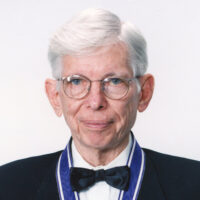
2004 Kyoto Prize Laureates
Life Sciences and Medicine(Molecular Biology, Cell Biology, Systems Biology, etc.)
/ Geneticist and Physician
1922 - 2016
Senior Advisor, Fox Chase Cancer Center
2004
11 /11 Thu
Place:Kyoto International Conference Center
Two Genetic Hits to Cancer : Past, Present and Future
2004
11 /12 Fri
13:00 - 17:30
Place:Kyoto international Conference Hall
In the early 1970s, Dr. Knudson proposed the “two-hit” hypothesis as a genetic mechanism of carcinogenesis through an elegant statistical analysis of retinoblastoma, a pediatric eye cancer. He soon advanced this hypothesis and reached the concept that mutational changes in “anti-oncogene”, now termed “tumor suppressor gene”, underlie the development of cancer. His “two-hit” hypothesis and the concept of “tumor suppressor” opened a new horizon in modern cancer genetics and played a pivotal role in the major developments in cancer researches.
*This field then was Field of Life Sciences (Molecular Biology, Cell Biology, Neurobiology).
Dr. Knudson proposed the “two-hit” hypothesis as a genetic mechanism of carcinogenesis, long before “oncogenes” or “tumor suppressor genes” were identified. He reached this hypothesis through a statistical analysis of retinoblastoma, a pediatric cancer often found with familial predisposition. Based on his “two-hit” hypothesis, Dr. Knudson also explained the recessive nature of the target genes affected by the two-hits at the cellular level, and coined such genes as “anti-oncogenes”, now called “tumor suppressor genes”. The hypothesis helped the discoveries of tens of key tumor suppressors, and is now established as one of the basic principles of cancer genetics.
By early 1970s, it was established that viral infections can cause cancers in animals , and transform cultured cells. Based on etiologic and chemical carcinogen studies, it was also proposed that successive multiple mutations accumulated for many years lead to cancer. Although these advances predicted dominant “oncogenes”, they could not explain hereditary or early-onset cancers.
Dr. Knudson who was trained as a physician and geneticist, focused on retinoblastoma patients who develop the tumor of the retina mostly in infancy, and often bilaterally. Using a statistical method, he found that bilateral hereditary cases fit for a one-hit phenomenon. The unilateral cases with no family history showed a distribution of two mutations. Because the hereditary form already harbored a germline mutation, both hereditary and nonhereditary forms of the tumor entailed the same number of events; hence “two-hit” hypothesis (1971).
Dr. Knudson soon advanced this hypothesis and proposed that the two mutational hits take place in the two alleles of the same recessive gene (1973) that he termed “anti-oncogene” (1982). He also predicted that the second event could be caused by mutation, deletion, chromosomal loss, recombination etc. This was proven by the other researchers in 1983, which led to the identification of RB1 as a tumor suppressor and its cloning in 1986.
Based on the “two-hit” hypothesis and using modern technology, researchers cloned some other tumor suppressor genes in the successive years, including WT1 (Wilms tumor) and BRCA1 (familial breast cancer). Another key tumor suppressor cloned independently also turned out to be inactivated by “two-hits”.
Based on his deep insights in clinical studies, Dr. Knudson formulated the simple and clear principle of the “two-hit” mutations to shed light on a complex mechanism of clinical cancer. His achievements stand high in today’s diversified and specialized life science researches.
For these reasons, the Inamori Foundation is pleased to present the 2004 Kyoto Prize in Basic Sciences to Dr. Alfred George Knudson, Jr.
Profile is at the time of the award.